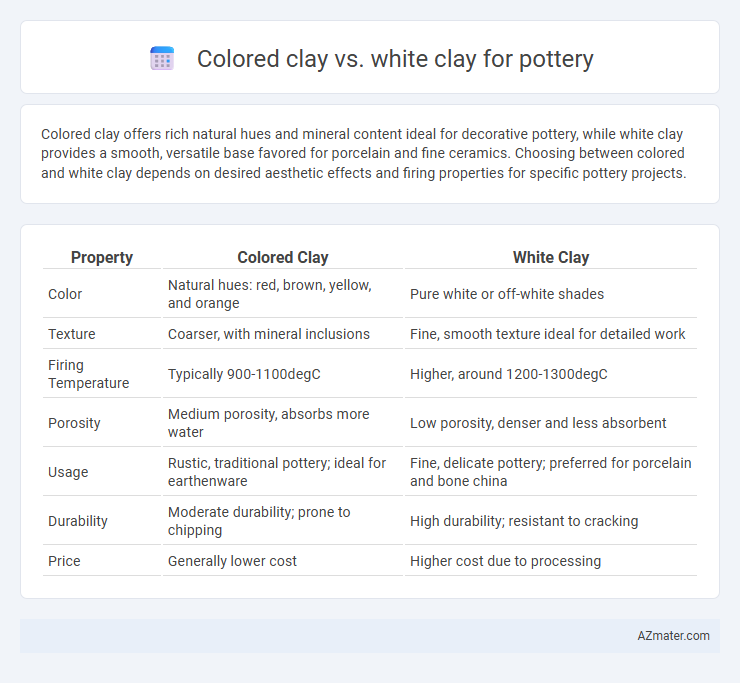Colored clay offers rich natural hues and mineral content ideal for decorative pottery, while white clay provides a smooth, versatile base favored for porcelain and fine ceramics. Choosing between colored and white clay depends on desired aesthetic effects and firing properties for specific pottery projects.
Table of Comparison
| Property | Colored Clay | White Clay |
|---|---|---|
| Color | Natural hues: red, brown, yellow, and orange | Pure white or off-white shades |
| Texture | Coarser, with mineral inclusions | Fine, smooth texture ideal for detailed work |
| Firing Temperature | Typically 900-1100degC | Higher, around 1200-1300degC |
| Porosity | Medium porosity, absorbs more water | Low porosity, denser and less absorbent |
| Usage | Rustic, traditional pottery; ideal for earthenware | Fine, delicate pottery; preferred for porcelain and bone china |
| Durability | Moderate durability; prone to chipping | High durability; resistant to cracking |
| Price | Generally lower cost | Higher cost due to processing |
Introduction to Colored Clay and White Clay
Colored clay, rich in natural minerals like iron oxide and copper, offers vibrant hues ranging from red and brown to green and blue, enhancing the visual appeal of pottery without additional glazes. White clay, primarily composed of kaolin, provides a pure, smooth, and neutral base ideal for fine porcelain and detailed decorative work due to its high plasticity and low impurity content. Both clays influence the final texture, firing temperature, and aesthetic properties of pottery, making the choice crucial depending on the desired finish and durability.
Key Differences Between Colored and White Clay
Colored clay contains naturally occurring iron oxides and other minerals that give it distinct hues such as red, brown, or yellow, influencing firing temperature and final pottery color. White clay, primarily composed of kaolin, is finer and purer with fewer impurities, resulting in brighter, more translucent ceramics ideal for detailed glazing. The mineral composition affects plasticity, firing range, and surface finish, making colored clay better for rustic designs and white clay preferred for fine, delicate pottery work.
Aesthetic Appeal and Visual Impact
Colored clay offers rich, natural hues that enhance the aesthetic appeal of pottery by providing vibrant, earthy tones without the need for additional glazing. White clay serves as a clean, versatile canvas that highlights intricate designs and surface textures with bright, crisp visual impact. Both clays influence the final pottery piece's artistic expression, with colored clay emphasizing warmth and depth, while white clay delivers clarity and contrast.
Suitability for Different Pottery Styles
Colored clay offers rich, natural hues suitable for rustic, textured pottery styles and decorative pieces requiring vibrant earth tones. White clay, known for its smooth, refined finish, is ideal for fine porcelain, detailed sculptures, and contemporary minimalist designs. Potters select between colored and white clay based on the desired aesthetic, firing temperature, and glaze compatibility to achieve specific artistic effects.
Workability and Handling Properties
Colored clay, often rich in iron oxides and other minerals, typically exhibits a denser texture that provides excellent plasticity but demands more water for optimal workability during pottery. White clay, primarily composed of kaolin, offers a smoother and finer consistency, making it easier to shape and handle, especially for delicate or detailed pottery work. Both clays require specific moisture control to prevent cracking, but white clay generally allows for better control and less shrinkage during drying and firing.
Firing Temperatures and Results
Colored clay, often rich in iron and other minerals, typically fires at temperatures between 1,800degF and 2,200degF (982degC to 1,204degC), producing warmer tones like reds, browns, and oranges due to oxidation during firing. White clay, which contains fewer impurities and lower iron content, usually fires at slightly higher temperatures around 2,100degF to 2,400degF (1,149degC to 1,316degC), resulting in a clean, bright finish ideal for glazing and fine detail work. The firing temperature directly influences the clay's hardness, porosity, and color outcome, with colored clay offering more earthy variations and white clay providing a smooth, neutral base for diverse artistic effects.
Glazing Options and Effects
Colored clay offers unique glazing effects by allowing the natural hue of the clay to subtly influence the glaze tone, creating richer and more complex surface textures. White clay serves as a neutral base that enhances the brightness and clarity of glazes, making vibrant colors and intricate patterns stand out more vividly. The interaction between clay color and glaze chemistry significantly affects the final visual effect, with colored clays often producing earthier, muted finishes while white clays highlight glossy and translucent glazes.
Durability and Strength Comparisons
Colored clay, often containing iron and other minerals, generally exhibits higher durability and strength due to its denser composition and natural firing qualities. White clay, typically kaolin-based, is softer and more porous, resulting in lower mechanical strength but allowing for finer detailing and smoother finishes. Pottery crafted from colored clay withstands wear and thermal changes better, making it preferable for functional ware requiring toughness.
Cost and Availability Factors
Colored clay, often sourced from specific mineral-rich regions, tends to be more expensive and less readily available than white clay, which is abundant and widely distributed globally. White clay, including varieties like kaolin, is typically cheaper due to its high availability and consistent quality, making it a preferred choice for mass production. Potters seeking unique hues often pay a premium for colored clays, while white clay offers cost efficiency and versatility in pottery creation.
Choosing the Right Clay for Your Pottery Projects
Colored clay contains natural minerals that provide rich hues and unique textures, ideal for decorative pottery and artistic pieces requiring vibrant aesthetics. White clay, known for its pure, smooth finish and high plasticity, is preferred for functional ware requiring fine detail and glazing compatibility. Selecting the right clay depends on the project's design goals, firing temperature, and desired surface treatment, ensuring optimal durability and visual appeal.

Infographic: Colored clay vs White clay for Pottery
 azmater.com
azmater.com